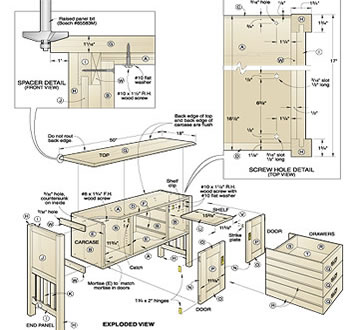Best selling wood projects - A Simple Utility Tray Project Part 2

Best selling wood projects

Once the outline of the first of the ends has been defined and cleaned up, the shape can be copied to the other end - and the process repeated to make both matching end pieces. Dont worry about the tapered sides just yet - well get to them later.
The centre handle, that was glued up from two pieces, has dried - and is ready to be shaped and have the handle hole cut.
I use a drill to give me a starting place, and cut again with the coping saw.

For the curves across the top, all of these saws will work well - perhaps a bandsaw with a narrow blade, best of all.
Since this project is one that youngsters might be making, Ill stick to hand tools.
The handle shape is my own design, worked out with the pair of compasses shown.

This shape has turned out quite well and pleases me. I took the trouble to make a template from it on a piece of scrap MDF. Ill save this, and use the design again for other projects in the future.
The curves all need finishing, and the harsh edges softened.
I like to use a spokeshave, but sandpaper can also be used - along with rasps and files if you have them.

To be accurate, the thickness of the centre handle piece needs to be measured first.
I find it easiest to mark the centre line of the ends, and measure half the thickness of the handle on either side of this centre line. This keeps things nicely middled.
These are cut to form the dado in the next step.

The left side cut has been completed, and the second cut on the right is nearly there.
This waste has now got to be removed. I use a chisel, and to prevent tear out at the ends, I chisel from each end towards the middle.
For this step the workpiece needs to be held firmly in place.

A couple of clamps with scraps for padding work well enough. These stop the clamps from marking the face of the timber.

Once again I have chosen a chisel - a long handled paring chisel this time. A hand router, like a Stanley 71, would work even better than this.
The sides of the dado need trimming as well, so that the handle will be a snug fit.
Side rebate planes are made for this job, and excel at it.

Mine is a right handed plane, that was made by an unknown craftsman years ago.
It has a rosewood body and a steel skate that houses the blade.
It is an absolute joy to use - my only regret is that I dont have the left handed version to go with it. This is sometimes needed when the grain runs in the other direction.

The picture of the antique tray in the first post, shows a much shallower angle than I would like.
I decided this angle by trial and error, until it struck a line that I liked.
I locked in this angle on the skew bevel, so that it could be used on the other end, and to create the slope on the two end pieces as well.

Not much further to go now. The two side pieces will be cut to match, and then the bottom will be attached.
These will appear in part 3.
Starting to look pretty nice I think.
Happy woodworking to all .......
Best selling wood projects
Best selling wood projects - A Simple Utility Tray Project Part 2
 Reviewed by teres
on
07.30
Rating:
Reviewed by teres
on
07.30
Rating:
 Reviewed by teres
on
07.30
Rating:
Reviewed by teres
on
07.30
Rating:
Tidak ada komentar: